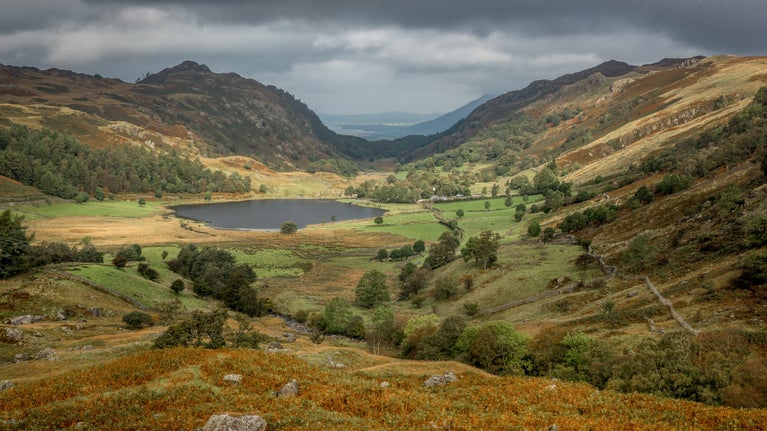
Discover more in the Lake District
Home of Beatrix Potter, dramatic landscapes and fascinating history.

There are lots of reasons to love and care for trees – whether you like climbing them, picnicking next to them or enjoy exploring forests. Here in the Lake District, our rangers look after trees every day – ancient trees, veteran trees, trees on nature trails for families to enjoy, even Beatrix Potter's bramley apple tree at Hill Top. We've gathered a collection of our favourites – find out more about them and where you can spot them.
We care for a whopping 5,835 ancient trees in the Lake District – that’s more than any other single owner in Europe – and it’s a big responsibility.
An ancient tree is one that is remarkably old for its species, which varies from species to species. And they are often solitary. Yews live the longest, some for as many as 4,000 years.
We know that one of the Borrowdale yews is at least 1,500 years old and William Wordsworth was moved to write a poem about them. A beech or ash tree can be old at 600 years, particularly if they were historically pollarded. Whereas a birch tree is considered ancient if it gets to 150 years old and, for a lime, it would be 350 years old.
- John Pring, Countryside Ranger and Farm Manager in the Lake District

We love trees that tell a story. Those that have stood for hundreds of years, limbs outstretched and leaves repeating an annual cycle of growing and falling. In the National Trust we call these ‘Veteran Trees’.
These are on the way to becoming the next generation of ancient trees, and may also be important both culturally and aesthetically. They're often associated with landscapes like Glencoyne Park near Ullswater, which has wood pastures, with over 250 veterans within its 200 hectares.
Veteran trees are also precious because as the tree grows it forms niches which wildlife depends on. These special trees can be home to rare wildlife. A 400-year-old oak tree can support more insects, fungi and lichens then five 100-year-old oak trees.
One notable veteran oak tree stands at the lakeshore of Fell Foot, on the south-east shore of Windermere. The tree has been there for 200-250 years and is an example of a great indicator of land management, planted and pollarded, to help stabilise the bank. It would have been a feature tree surrounded by a 19th-century beech wood. A reminder that Fell Foot was once the parkland to a villa style property which, as it rose in status included a boathouse complex built next to the oak.
- Gemma Wren, Countryside Manager for the National Trust in South East Cumbria and Morecambe Bay

Beatrix Potter planted and cared for her own apple tree at Hill Top. It’s now thought to be about 100 years old. We've looked after it since it was left in our care, and even created a clone in case something happens to the original.
One of the Lake District's oldest trees at 300-350 years old, the ancient Dalston Oak at Acorn Bank gives us a glimpse into the past. It’s important to the landscape, wildlife and visitors to the area. It is part of the ancient woodland that was once here and is named after John Dalston III who made a lot of changes to the old house and the parkland.
In Dog Kennel Wood on the Sizergh estate is a Douglas fir – not one of our ancient trees but a veteran tree none-the-less. At 60 metres tall, and with an impressive 232cm girth, it towers over every other tree, one with a real ‘wow’ factor.
Another veteran tree to head for if you’re walking at Arnside Knott is the knotted larch trees. Now dead, the two pairs of larches form an ‘h’ shape. The story goes that the two saplings were tied together by a sailor and his bride on their honeymoon in around 1862.
Planted in around 1860 as part of an arboretum at the Wansfell Holme country estate just outside Ambleside, this grand fir is the tallest tree in the Lake District and the tallest of its kind in the UK measuring over 58 metres.

- John Pring, Countryside Ranger and Farm Manager in the Lake District

Home of Beatrix Potter, dramatic landscapes and fascinating history.
Ash dieback is a fungal disease affecting the country’s native ash trees. As many as four out of five ash trees may be affected and, where the dying trees could cause a threat to human safety, we need to remove them.

Ancient trees are links to our past, they're species-rich habitats that support countless other organisms. Discover what makes a tree ancient and how to recognise them.

Learn about forest bathing, a way of relaxing and slowing down the mind by immersing yourself in nature. It can help reduce blood pressure, lower stress levels and improve concentration.

Find out how we're planting and establish 20 million trees that will absorb carbon and help tackle climate change.